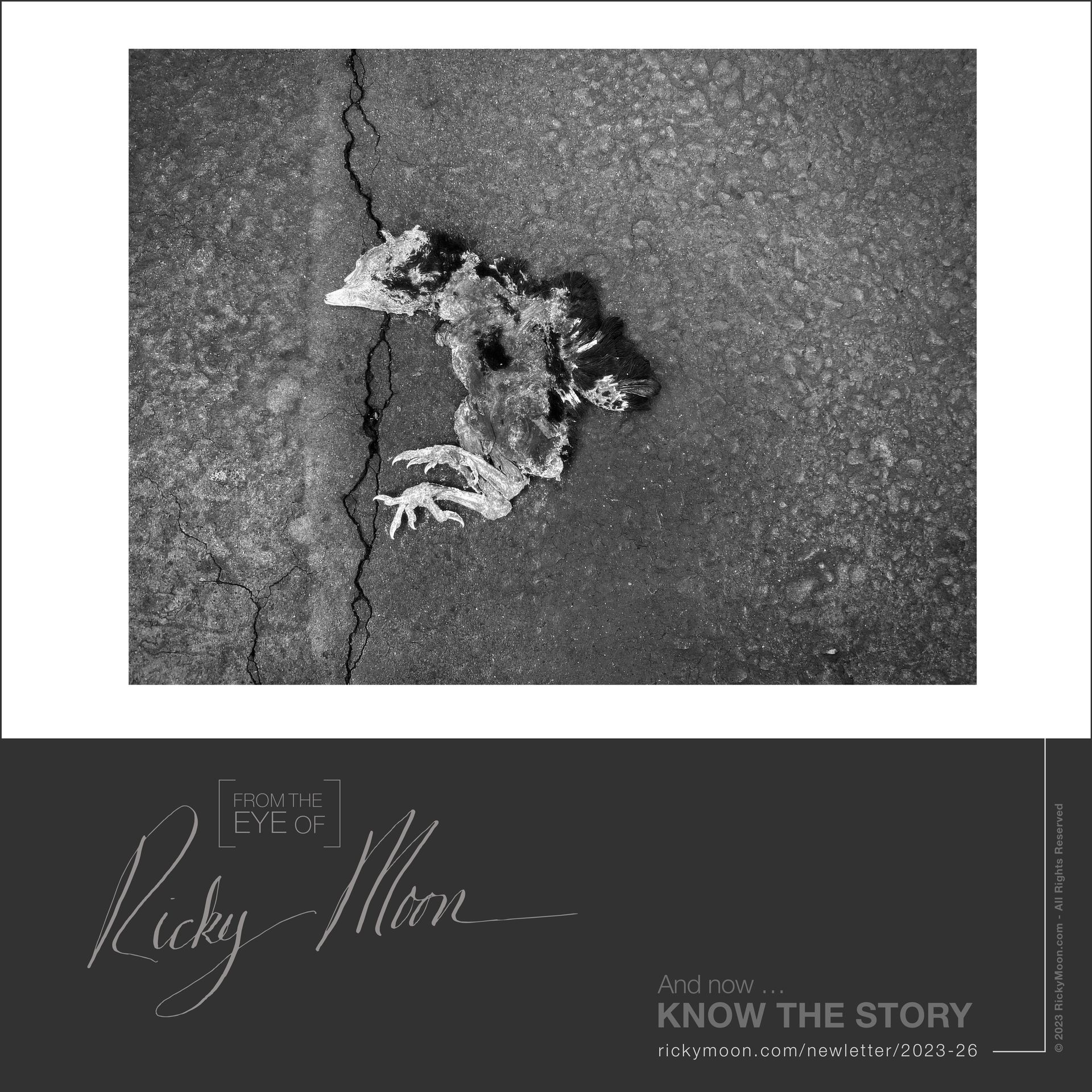
2023.26 : Suicide By Human
U.S.A. Circa 2023
— Abraham MaslowThe most fortunate are those who have a wonderful capacity to appreciate again and again, freshly and naively, the basic goods of life, with awe, pleasure, wonder and even ecstasy.
“Experience isn’t identity.” With these three words, John O’Donohue dissolved the persistent misconception that the two are one and the same, thus enriching my life. To rephrase this, our identities do not emerge from our experiences. That’s why people don’t change fundamentally, only their pretenses do. Experiences are like raindrops on a car—they can rust, discolor, damage, dirty, or even clean a car, but they can never make a car.
“Experience” is self-explanatory. But what, then, is identity? I choose to believe that identity is an instance of consciousness, like a rain drop is an instance of the oceans, the defining factor of what it means to be a living creature, from the greatest to the smallest. Everything else is merely matter.
Some believe that consciousness permeates matter, enduring beyond death. So far, no evidence of these claims has convinced me. Where does consciousness come from, and where does it go? I don’t know, and the good news is, such knowledge isn’t necessary to live fully in the present.
I believe there’s only one type of consciousness, shared across all sexes, races, ages, cultures, and species, regardless of the “meat prison” it finds itself in. The make, model, and condition of our bodies, as well as our nurture and nature, shape the lived experience through which consciousness witnesses the world.
That’s why a human woman’s lived experience cannot be the same as a man’s, and vice versa. Similarly, an elephant’s lived experience differs from that of a human. A dog’s or cat’s experience is distinct from an elephant’s.
I have made direct eye contact with an elephant with less than two feet between us. I asked his conscientious handler, a.k.a. a benevolent prison guard (no chains or shackles used on their elephants—that I won’t tolerate), if it was okay for me to approach and “ask” the elephant for permission to get on his back. The handler, most pleased with the request, granted it. What I saw in the elephant’s eyes shocked me to my core. The elephant and I were like two prisoners who couldn’t speak each other’s language, at least being able to acknowledge a fellow creature of consciousness was present. Bowing my head was the best I could do to thank the elephant for what I presumed was permission granted. Later on the jungle ride, another, less experienced handler needed assistance. As our handler jumped off to give assistance, he said as he was sliding off this majestic creature, “Don’t worry, he’ll take care of you.” My girlfriend at the time cracked a smile my way shaking her head in disbelief. We sat there safe and sound until the handler could return. When the ride was over, I thanked the elephant with a gaze, a bow, and a pat.
In Genesis 1:26, it says, “that they may rule over the fish in the sea and the birds in the sky, over the livestock and all the wild animals, and over all the creatures that move along the ground.” I find this verse repugnant because it commands we deny the acknowledgement of consciousness in other species. Honoring that sacred bond can be achieved without backing into anthropomorphism.
All that to say…
Someone close to me is a specialist in animal welfare. Before writing this essay, I shared the following story with them to ensure I didn’t violate either my own ethical principles or theirs concerning animals. They provided reasons to explain why the actions taken were the most humane and environmentally conscious options, given the circumstances. You may disagree, and I would understand.
The oddities started little over a week ago when I found a bird run over in a parking lot. Normally, I don’t photograph such scenes, but after a few days, nature had transformed it into such a striking image that I felt compelled to capture it. I had no intention of publishing it, but then things got even weirder, leading to the photograph accompanying this essay.
A couple of days later, in the same parking lot, I exited my vehicle. At the base of a tree, a bird appeared to be nesting on the ground. I approached, and it stared back. The poor thing looked ill. When I returned in the afternoon, it was gone.
The next day, I spotted the same bird sitting between cars. Now, it was clear the bird was ravaged with disease. Unable to fly and with death imminent, thoughts of taking it to a vet crossed my mind. For a host of reasons, however, I decided against it. Filling me with emotions I immediately suppressed.
But then… things got weirder.
As I approached the front door of the building complex, I spotted a second bird (bird #2) similar in appearance and equally as ill as the first one (bird #1.) This second bird was cowering at the building’s entry sliding door. The residents wanted to help it, but it was clear that the grim reaper had a firm grip on the poor creature.
The afternoon arrived, and bird #2 had managed to pull itself a few feet into the shrubs. I went back inside, fetched an appropriately-sized container, and filled it with water. If all I could offer was a little comfort during its final hours, so be it. I didn’t get too close when I set the water down.
But then… I was yelled at.
In the tree overlooking this melodrama was a crow. It began yelling at me, not squawking, but actual bird-yelling. I faced the crow, and nodded. The animal expert I spoke to suggested that the crow wasn’t accusing me of trying to steal a meal. We both preferred to believe it was warning me to stay away because of a possible communicable disease. There were three cats that patrolled the parking lot, and they kept clear of the sick birds the entire time.
After running errands and returning, bird #2 was gone. I felt a sense of relief. Time to go home finally came. As I was leaving, I decided to take the water to bird #1, who was still lingering between cars. He just looked at me, exhausted.
The next morning, bird #1 wasn’t around. However, I found bird #2 had died in the shrubs. Rest in peace, little one.
The day passed. Time to go home arrived, but it wouldn’t be easy.
As I approached my car, I saw bird #1 behind my front passenger-side tire, half in the shade, half in the intense sun. I tried to shoo the poor creature away, but it refused to budge. Instead, it slowly turned its head and looked directly at me. We made eye contact. My mind translated its gaze into a plea: “You know what to do. Please, do this for me.”
I resisted the thought. No, no, and no.
I got into my car and turned on the engine, deciding to wait five minutes for the bird to move away from my tires. If it didn’t, I realized I would be compelled to act. The five minutes passed slowly. If this little conscious being wanted a quick end from a human, who was I to prolong its suffering as it was being eaten alive by an invisible enemy? My own human body, the product of luck rather than design, endowed me with the means and responsibility to make its passing quick and devoid of extra suffering.
I performed calculations in my head over and over again. This angle versus that angle, this rate of acceleration versus another, and so forth. I checked my conscience for the umpteenth time, put the car in drive, kept my foot on the brake, and checked my conscience one last time.
It was done. I got out of the vehicle and kept my distance. I saw that he didn’t suffer due to my actions. I tapped my heart with my fist, observed a moment of silence, and wished the little one a peaceful rest.
It was finally time to go home and shake off the experience. But as you may have guessed, things only got even weirder.
Now, heading home on the eight-lane freeway, I noticed something moving away from the divider and into the lanes out of the corner of my eye. Was it a box? Then it came into focus. It was a squirrel! The largest I have seen in the area. What struck me was the size of his tail, and as you are about to read, more of a rudder.
Someone was going to slam on their brakes, and this day would end with many of us in a hospital bed. Thankfully, no one saw the squirrel. There wasn’t even the slightest tapping of brakes.
The squirrel executed a series of parkour moves that I wouldn’t have believed if I hadn’t seen them with my own eyes. Bursts of incredible speed between cars. Slamming on its little “brakes” at each painted lane line. Rapid head movements accessing it’s next move in fractions of a second. Then boldly dodging what sped by. It reached the safety of the trees lining the freeway shoulder. Absolutely incredible. I let out a cheer as I would for any athlete beating the odds.
Then it dawned on me…
This super squirrel hadn’t merely crossed four lanes. It must have traversed eight! It either had made it halfway across and then doubled back, or it simply had aimed to reach the other side of all eight lanes. In any event, the feat was truly a death-defying spectacle.
What a day. What a week.
A death granted. A death denied. The week concluded with a life begetting more life. A young peach tree for which I care yielded its first true bounty, brimming with incredible flavors. Then came the realization that all the remaining peaches would ripen within a single forty-eight-hour window. You know what that means: time for pie! Here are some snapshots to reiterate my point from a previous photo essay. Why eat cake when pie exists?
And now… know the photograph.


